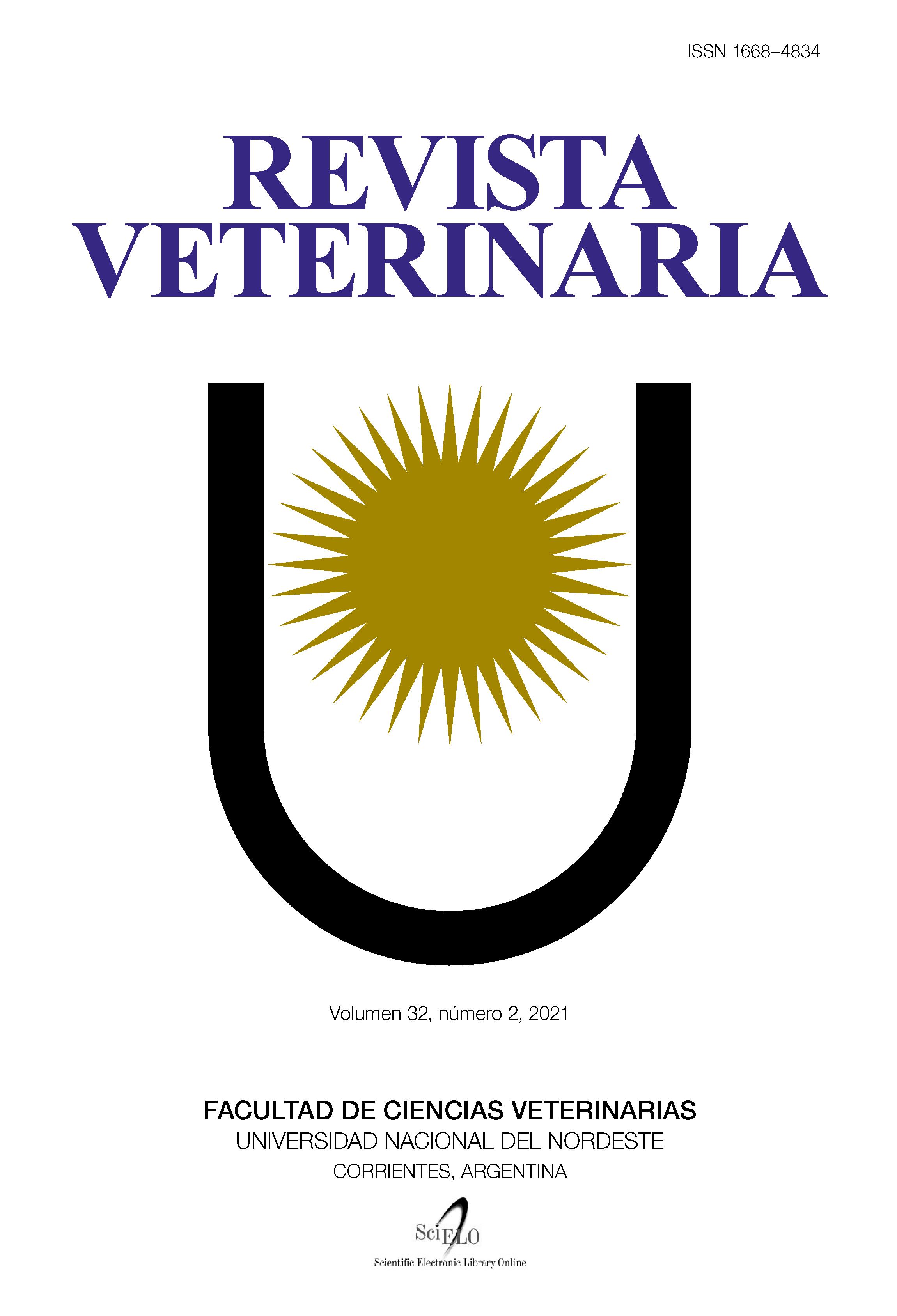Efecto de dos diluyentes sobre la tasa de preñez por inseminación artificial laparoscopica en ovinos
DOI:
https://doi.org/10.30972/vet.3225747Palabras clave:
Criopreservación, espermatozoides, gestación, ovinos, ultrasonografíaResumen
El objetivo del estudio fue evaluar dos diluyentes comerciales para el congelamiento de semen ovino y determinar su efecto en la tasa de preñez al ser utilizados en inseminación artificial laparoscópica. El semen utilizado fue de un carnero Dorper adulto, cuyo eyaculado fue dividido en dos: una alícuota fue diluida con un diluyente comercial con base de lecitina de soya y la otra con un diluyente con base de yema de huevo. El semen fue criopreservado (100 x 106 espermatozoides móviles) y cada tipo de dilución fue utilizado para inseminar 15 ovejas. Las hembras fueron sincronizadas con esponjas intravaginales e inseminadas vía laparoscó- pica. El diagnóstico de preñez por ecografía se hizo a los 60 días del servicio. Los resultados indicaron una tasa de preñez de 85% con semen diluido en base de lecitina de soya y 78% con yema de huevo, no habiendo diferencias significativas entre tratamientos. Se concluye que la tasa de preñez obtenida con los dos diluyentes utilizados es similar, por lo cual ambos ofrecen los mismos beneficios a la hora de implementarlos en un programa reproductivo para la especie ovina, mediante inseminación artificial laparoscópica.
Descargas
Citas
Aboagla EM, Terada T. 2004. Effects of egg yolk during the freezing step of cryo-preservation on the viability of goat spermatozoa. Theriogenology 62: 1160-1172.
Álvarez Met al. 2012. Design and in vivo evaluation of two adapted catheters for intrauterine transcervical insemination in sheep. Anim Reprod Sci 131: 3-4, 153-159.
Anel L et al. 2005. Factors influencing the success of vaginal and laparoscopic artificial insemination in churra ewes: a field assay. Theriogenology 63: 4, 1235-1247.
Avendaño R Let al. 2007. Reproduction performance of Pelibuey ewes in response to estrus synchronization and artificial insemination in northwestern Mexico. J Anim Vet Adv 6: 807-812.
Bari F et al. 2001. The repeatability of super-ovulatory response and embryo recovery in sheep. Theriogenology 56: 147-155.
Cámara DR, Guerra MM. 2011. Refrigerafao e criopreservafao do semen ovino: danos inerentes á técnica e influencia da suplementafao do meiocom antioxidantes sobre a qualidade espermática. Rev Bras Reprod Anim 5: 33-40.
Evans G, Maxwell W M. 1990. Inseminación artificial de ovejas y cabras, Editorial Acriba, Zaragoza, pag. 204.
Flores J P et al. 2017. Evaluación de la utilización de semen congelado y refrigerado en la inseminación artificial por laparoscopía en la especie ovina. AICA 9: 41-47.
Fukui Y, Kohno H, Togari T, Hiwasa M, O kabe K. 2008. Fertility after artificial insemination using a soybean-based semen extender in sheep. J Reprod Develop 54: 286-289.
Hernández L et al. 2014. Efecto de dos diluyentes a base de lecitina de soya sobre parámetros morfométricos en semen caprino. SENNOVA (Sistema de investigación, desarrollo tecnológico e innovación), 1: 30-43.
Herold FC, Haas K, C olenbrander B, Gerber D. 2006. Comparison of equilibration times when freezing epididymal sperm from African buffalo (Syncerus caffer) using Triladyl or AndroMed. Theriogenology 66: 1123-1130.
Kaabi M et al. 2006. Influence of breed and age on morphometry and depth of inseminating catheter penetration in the ewe cervix. Theriogenology 66: 1876-1883.
Kershaw CM et al. 2005. The anatomy of the sheep cervix and its influence on the trans-cervical passage of an inseminating pipette into the uterine lumen. Theriogenology 64: 1225-1235.
Macías A et al. 2017. Technical note. A new device for cervical insemination of sheep-design and field test. J Anim Sci 95: 5263-5269.
Masoudi R et al. 2017. Fertility response of artificial insemination methods in sheep with fresh and frozenthawed semen. Cryobiology 74: 77-80.
Mellisho E, Terrel W. 2007. Tasa de no retorno después de inseminación intrauterina vía laparoscópica con semen congelado de carneros australianos. Sitio Arg Prod Anim (APPA-ALPA), Cusco, Perú.
Pau S et al. 2019. Surgery on cervical folds for transcervical intrauterine artificial insemination with frozen-thawed semen enhances pregnancy rates in the sheep. Theriogenology 1: 126, 28-35.
Pau S et al. 2020. Reproductive performance following transcervical insemination with frozen thawed semen in ewes submitted to surgical incision of cervical folds (SICF). Animals 10: 1, 108.
Paulenz H et al. 2004. Fertility results after different thawing procedures for ram semen frozen in minitubes and mini straws. Theriogenology 61: 1719-1727.
Salamon S, Maxwell W M . 1995a. Frozen storage of ram semen. I. Processing, freezing, thawing and fertility after cervical insemination. Anim Reprod Sci 37: 185-249.
Salamon S, Maxwell W M. 1995b. Frozen storage of ram semen II. Causes of low fertility after cervical insemination and methods of improvement. Anim Reprod Sci 38: 1-36.
Salamon S, Maxwell W M. 2000. Storage of ram semen. Anim Reprod Sci 62: 77-111.
Watson PF. 2000. The causes of reduced fertility with cryo-preserved semen. Anim Reprod Sci 60: 481-492.
Wulster MC, Lewis GS. 2002. Development of a new trans-cervical artificial insemination method for sheep: Effects of a new trans-cervical artificial insemination catheter and traversing the cervix on semen quality and fertility. Theriogenology 15: 58(7), 1361-1371.
Descargas
Publicado
Cómo citar
Número
Sección
Licencia
Política de acceso abierto
Esta revista proporciona un acceso abierto inmediato a su contenido, basado en el principio de que ofrecer al público un acceso libre a las investigaciones ayuda a un mayor intercambio global de conocimiento. La publicación por parte de terceros será autorizada por Revista Veterinaria toda vez que se la reconozca debidamente y en forma explícita como lugar de publicación del original.
Esta obra está bajo una licencia de Creative Commons Reconocimiento-NoComercial 4.0 Internacional (CC BY-NC 4.0)








